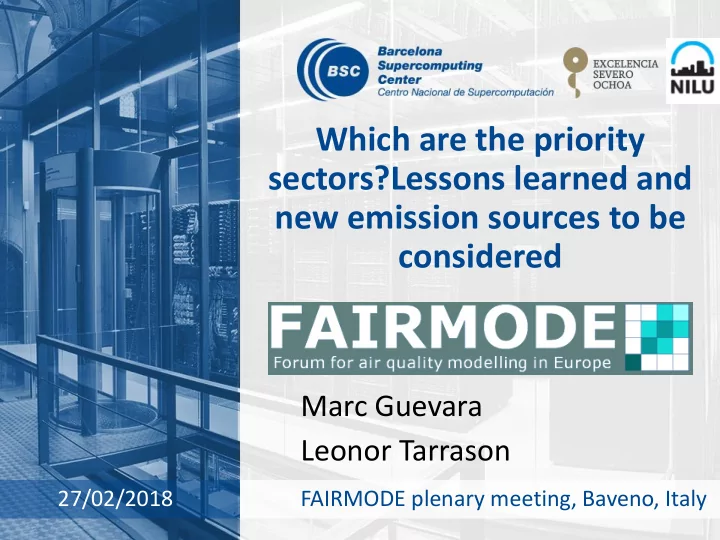

Which are the priority sectors?Lessons learned and new emission sources to be considered Marc Guevara Leonor Tarrason 27/02/2018 FAIRMODE plenary meeting, Baveno, Italy
Emissions in the Era of Big Data Big and heterogeneous data is constantly being generated by a diversity of sources, but we are still asking the same questions: • How many diesel EURO IV passenger cars pass through this street? • What is the stack height of this industry? • How many wood is being consumed in this district? • When is the farmer applying fertilizers to this type of crop? Are there new methods/tools (e.g. data analytics, data mining) that we can apply to improve the access to this (basic) information?
A specific challenge for each source Industrial Combustion Residential Agriculture Combustion Use of Road Transport Solvents Activity/Emission Factors Spatial Allocation Temporal Allocation Speciation
Road Transport • NO x : In general, good agreement between top-down and bottom-up and top-down emission inventories. But … Trombetti al. (AE, 2018) Guevara al. (AQAH, 2016)
Road Transport • NO x : In general, good agreement between top-down and bottom-up and top-down emission inventories. But … • Does it mean that both emission inventories are correct? (none of them can be taken as “the reference ”) Diesel PC EURO V 1.25 COPERT IV COPERT V 1.00 EF [g/km] 0.75 0.50 0.25 0.00 0 20 40 60 80 100 120 Av. Speed [km/h] Emission inventories need to take into account real world observations
Road Transport • Vehicle fleet composition profile Average passenger car registration year in Barcelona Low Emission Zone (December 2017) REGISTERED CIRCULATING 2009 2003 Petrol cars registered before 2000 Diesel cars registered before 2006 Vans registered before 1 October 1994 Number plate recognition systems: A necessary input for AQ planning (WG4)
Road Transport • PM10: Member States are not requested to include resuspension traffic related sources in their official emission inventories. But … Lopez-Aparicio al. (AE, 2016)
Road Transport • PM10: Member States are not requested to include resuspension traffic related sources in their official emission inventories. But … There is hope! Sweden’s submission 2015: Resuspension included (increase almost a factor 2) TNO MACC-iii 2011 PM10 EMEP 2015 SLB 2015 (tons/yr/km 2 ) EMEP 2015 SLB 2015 TNO MACC-iii 2011
Road Transport • Spatial distribution: urban / interurban / rural roads How to get the correct balance in top-down emission inventories? HERMESv2.0 (2013) TNO MACC-III (2011) JRC (2010) EMEP (2015) 1kmx1km 7kmx7km 1kmx1km 0.1x0.1 deg Is it possible to report in the IIRs the spatial proxies and methods used? NOx (tons/yr/km 2 )
Residential Combustion • Spatial allocation: Where is the wood being burned? Norway Finland Helsinki City center Lopez-Aparicio al. (JEM, 2017)
Residential Combustion • PM Emission Factors: • National emission factors used on official reporting show a considerable range Should the emission factor be also country-oriented?
Industries • Spatial allocation: LPS: Is E-PRTR reliable enough? MCP: Which is the best spatial proxy? Antwerp TNO_MACC-II: total population TNO_MACC-III: Industrial land cover CORINE Land Cover: sanatoriums, spa facilities, Ton/year NO x PM 10 PM 2.5 hospitals, military bases, educational Local dataset (2012) 12488 425 219 establishments, university sites, commercial CLRTAP (2010) 12589 0 0 centres bordering on or outside urban districts E-PRTR (2012) 11422 106 0 are also associated with this category .
Industries • Spatial allocation: Land Cover examples – CORINE 2006 (Barcelona) Dark red: industrial land use Red: continuous urban land use Light Red: discontinuous urban land use
Industries • Spatial allocation: Land Cover examples – CORINE 2006 (Oslo) Dark red: industrial land use Red: continuous urban land use Light Red: discontinuous urban land use Is it time to define a better industrial land use category?
Agriculture Agriculture Fertilizer/Manure Livestock Crop Operations Vegetation Waste Burning Application (NH 3 ) (PM) (NH 3 ) (PM) (NH 3 ) Covered by regional (top-down) annual emission Covered by online models inventories (usually not included in bottom-up urban (MEGANv2.1, GFASv1.2) emission inventories)
Agriculture Sources and geographical origins of fine aerosols in Paris (Bressi et al., ACP, 2013): More than 50% of PM 2.5 levels are associated with (mid to) long-range transported pollution A seasonal pattern strongly influenced by agricultural emissions (meteorology, fertilizer application practices and legal restrictions)
Agriculture • Temporal allocation: Is a static (spatially constant) temporal profile representative enough? In line with colder winter (e.g. Denmark) In line with warmer climate (e.g. the Netherlands) Backes et al. (AE, 2016) STP is the commonly used temporal disaggregation scheme for NH 3 in current CTMs for Europe Is there a need for a gridded temporal profile for NH 3 agricultural emissions?
Use of Solvents Change in inventories of urban NMVOC sources: • Transportation emissions have declined rapidly. • The use of volatile chemical products (VCPs) (e.g. personal care products) now constitutes half of fossil fuel NMVOC emissions EMEP-CEIP (2018)
Use of Solvents Human exposure to carbonaceous aerosols of fossil origin is transitioning away from transportation-related sources and toward use of VCPs. Straight, branched, and cyclic alkanes (42 ± 4%) McDonald et al. (Science, 2018) Alkenes and terpenes (17 ± 5%) Aromatics (12 ± 3%) Should we focus more on the speciation profiles that we are using?
Urban CO 2 emissions Global Covenant of Mayors for Climate and Energy (2016): Signed by more than 600 cities To reduce their greenhouse gas emissions and create robust inventories Disagrements between local (bottom-up) and current global emission inventories exceed 100% for large urban areas. Should we include this pollutant in our to do list?
Points for discussion Road transport: How do we communicate our findings? Residential Combustion: Do we need spatial proxies that are more (i) “ emission inventory” oriented? (ii) heterogeneous (i.e. take into account local cultural factors)? Next priorities: • Industry • Agriculture • Use of solvents • Temporal distribution • Speciation • CO 2 in urban areas
Thank you marc.guevara@bsc.es
Recommend
More recommend